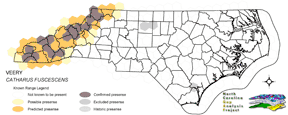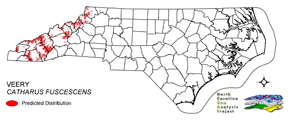
| Taxa: |
| Order: |
| Family: |
| Aves |
| Passeriformes |
| Turdidae |
| NatureServe Global Rank: |
| NatureServe State (NC) Rank: |
| G5 |
| S4B,SZN |
| Federal Status: |
| NC State Status: |
| --- |
| --- |


| Land Unit |
| US Fish & Wildlife Service |
| US Forest Service |
| US National Park Service |
| US Department of Defense |
| NC State Parks |
| NC University System |
| NC Wildlife Res. Com. |
| NC Forest Service |
| NC Div. of Coastal Mgmt. |
| Local Governments |
| Non-Governmental Org. |
| Other Public Lands |
| Private Lands |
| GAP Status 1-2 |
| All Protected Lands |
| Statewide |
| Hectares |
| 0.00 |
| 113,325.48 |
| 0.00 |
| 56,553.39 |
| 650.16 |
| 45.27 |
| 1,562.31 |
| 1.47 |
| 0.00 |
| 4,207.05 |
| 4,364.82 |
| 0.00 |
| 147,740.67 |
| 77,863.35 |
| 180,640.20 |
| 328,450.62 |
| Acres |
| 0.00 |
| 280,033.31 |
| 0.00 |
| 139,746.44 |
| 1,606.58 |
| 111.86 |
| 3,860.55 |
| 10.90 |
| 0.00 |
| 10,395.84 |
| 10,785.70 |
| 0.00 |
| 365,075.08 |
| 192,411.76 |
| 446,378.83 |
| 811,626.26 |
| % of Dist. on |
| Prot. Lands |
| 0.0 % |
| 62.7 % |
| 0.0 % |
| 31.3 % |
| 0.4 % |
| < 0.1 % |
| 0.9 % |
| < 0.1 % |
| 0.0 % |
| 2.4 % |
| 2.4 % |
| 0.0 % |
| 0.0 % |
| 43.1 % |
| ----- |
| ----- |
| % of Dist. on |
| All Lands |
| 0.0 % |
| 34.5 % |
| 0.0 % |
| 17.2 % |
| 0.2 % |
| < 0.1 % |
| 0.5 % |
| < 0.1 % |
| 0.0 % |
| 1.3 % |
| 1.3 % |
| 0.0 % |
| 45.0 % |
| 23.7 % |
| ----- |
| ----- |
|
Found only in the mountain region, which represents the southern-most limit of the speciesĘ breeding range (Potter et al. 1980). Found primarily near water in damp deciduous forests with a dense understory and ground cover. Also in more open mature forests, but restricted to brushy areas along water (Kaufman 1996). In the mountains of North Carolina, breeds in the spruce-fir zone and also the northern hardwoods, where its range overlaps that of the Wood Thrush (Potter et al. 1980). Nests may be built on the ground, a brushpile, or a stump, or several feet up on a horizontal limb of a tree or shrub (Nicholson 1997). Nests on the ground are often built against a stump or log or in a clump of vegetation (Kaufman 1996). NATURE SERVE GLOBAL HABITAT COMMENTS: Poplar, aspen, or other swampy forest, especially in more open areas with shrubby understory, also in second growth, willow or alder shrubbery near water; large tracts of forest are most suitable. In Illinois, nesting occurred in forest patches of 27-1000+ ha; only 2 of 22 patches were smaller than 100 ha; mean patch size was 309 ha; patches used for nesting tended to be surrounded by other forested habitat (Herkert 1995). In Wisconsin, nesting was much more likely in forest patches larger than 100 ha than in smaller patches (Temple, cited by Herkert 1995). Robbins et al. (1989) found that nesting in the mid-Atlanitc states was most likely in forest patches of 3000 ha or larger but breeding sometimes occurred in patches as small as 9 ha. Associated with large (>8 ha) aspen groves in Saskatchewan (Johns 1993). In migration and winter also in lowland forest, woodland, and scrub. Nests usually on or near ground, at base of shrub, in clump of weeds, in shrub or low tree (Terres 1980). |
| Code | Name | Description | NC Natural Heritage Program Equivalent |
| 521 | Spruce/Fir Forest | High Elevation Frazer-Fir - Red Spruce, Red Spruce and Red-Spruce-Yellow Birch Forests. Tree densities included here include both woodland to forest density. Highly intermixed with Northern Hardwoods, Grassy Balds, and Shrub Balds. | Red Spruce--Fraser Fir Forest, Fraser Fir Forest |
| 522 | Northern Hardwoods | High Elevation forests including yellow birch, American beech, and yellow buckeye. Includes forests with Hemlock and Yellow Birch. | Northern Hardwoods Forest, Boulderfield Forest |
| 525 | Appalachian Oak Forest | A variety of oak forest types including Black, White, Scarlet Oaks in dry to mesic situations. Includes forests historically co-dominated by American Chestnut. | High Elevation Red Oak Forest, Montane White Oak Forest |
| 526 | Appalachian Cove Forest | Mixed Mesophytic forests of the mountains. Includes tuliptree, basswood, yellow buckeye and surgar maple. This class is mapped to include cove forests dominated or co-dominated by hemlock. | Rich Cove Forest, Acidic Cove Forest |
| 527 | Appalachian Hemlock | Upland hemlock forests of the moutains region. Vary from side slopes to steep slope positions. | Canada Hemlock Forest |
|
Johns, B. W. 1993. The influence of grove size on bird species richness in aspen parklands. Wilson Bull. 105:256-264.
Herkert, J. R. 1995. Status and habitat area requirements of the veery in Illinois. Auk 112:794-797. Carter, M., G. Fenwick, C. Hunter, D. Pashley, D. Petit, J. Price, and J. Trapp. 1996. Watchlist 1996:For the future. Field Notes 50(3):238-240. Bent, A. C. 1949. Life histories of North American thrushes, kinglets, and their allies. U. S. Nat. Mus. Bull.196. 452 pp., 51 pls. Hagan, J.M., III, and D.W. Johnston, editors. 1992. Ecology and conservation of neotropical migrant landbirds. Smithsonian Institution Press, Washington, D.C. xiii + 609 pp. Herkert, J. R., editor. 1992. Endangered and threatened species of Illinois:status and distribution. Vol. 2:Animals. Illinois Endangered Species Protection Board. iv + 142 pp. Sauer, J.R., and S. Droege. 1992. Geographical patterns in population trends of neotropical migrants in North America. Pages 26-42 in J.M. Hagan III and D.W. Johnston, editors. Ecology and conservation of neotropical migrant landbirds. Smithsonian Institu Nicholson CP. 1997. Atlas of the breeding birds of Tennessee. Knoxville: University of Tennessee Press. Robbins, C. S., J. R. Sauer, R. Greenberg, and S. Droege. 1989. Habitat area requirements of breeding forest birds of the middle Atlantic states. Wildl. Monogr. 103:1-34. Harrison, C. 1978. A field guide to the nests, eggs and nestlings of North American birds. Collins, Cleveland, Ohio. Harrison, H.H. 1979. A field guide to western birds' nests. Houghton Mifflin Company, Boston. 279 pp. Potter, E. F., J. F. Parnell, and R. P. Teulings. 1980. Birds of the Carolinas. Univ. North Carolina Press, Chapel Hill. 408 pp. Terres, J.K. 1980. The Audubon Society encyclopedia of North American birds. Alfred A. Knopf, New York. American Ornithologists' Union (AOU), Committee on Classification and Nomenclature. 1983. Check-list of North American Birds. Sixth Edition. American Ornithologists' Union, Allen Press, Inc., Lawrence, Kansas. Hilty, S.L., and W.L. Brown. 1986. A guide to the birds of Colombia. Princeton University Press, Princeton, New Jersey. 836 pp. Ridgely, R.S., and G. Tudor. 1989. The birds of South America. Vol. 1. The Oscine passerines. Univ. Texas Press, Austin. 516 pp. Stiles, F.G., and A.F. Skutch. 1989. A guide to the birds of Costa Rica. Comstock Publ. Associates, Cornell University Press, Ithaca, New York. 511 pp. Droege, S., and J.R. Sauer. 1990. North American Breeding Bird Survey, annual summary, 1989. U.S. Fish and Wildlife Service, Biological Report 90(8). 22 pp. |
For more information please contact them at:
NC-GAP Analysis Project
Dept. of Zoology, NCSU
Campus Box 7617
Raleigh, NC 27695-7617
(919) 513-2853
www.basic.ncsu.edu/ncgap